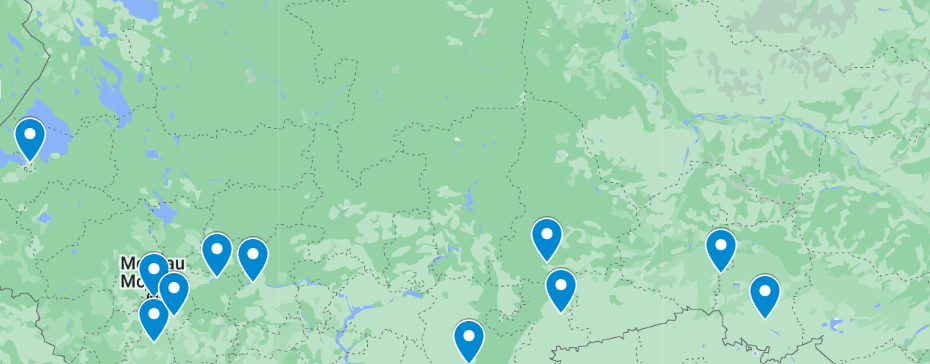A Closer Look At Russian Military Railway Infrastructure
Russia has one of the biggest railway systems in the world which is hugely important to the Russian Military.

Russia is the biggest country in the world, and because of that, it has one of the biggest railway systems in the world which is hugely important to almost every facet of Russian life. Russia is so big that it has different types of climate zones, spread across vast regions and its economy relies heavily on the export of natural resources, making trains a critical part of the country's public infrastructure.
Railway Basics
Constructing railways is complicated, everybody wants to be on time and be able to drive anywhere they please in a short amount of time. People take trains for visiting others, going to work etc., companies want to transport their goods quickly, efficiently. Meanwhile, train networks have to be, or should be reliable.
To solve these problems, many algorithms and tactics have been developed. Since this is a rather complicated topic, I'm going to drastically oversimplify. Aiding me in this explanation is going to be the game "Mini Metro".

Mini Metro is a game where you have to organize a railway system of a city. In the normal mode you can change railway routes (mostly) as you please, while your goal is to get passengers to their destination and stop stations from overcrowding.
Just so you get a better picture of how it looks and feels, I'm gonna make a quick demonstration.




As I told you, very easy and straightforward till now. What can you take away from this and apply to the real world though?
- There are different type of stations, well kind of. Some stations are built to get workers to their job, others are made for tourists and yet other stations are built to get goods across or through the country. This doesn't mean that a station has to be exclusive for one purpose.
- The same goes for the railways themselves.
- Different people from different locations want to get to specific stations. This can be derived from the points mentioned along with "common sense" above as well.
Additionally, you want travelling time to be low, keep lines as short as possible and use the minimum amount of resources.
Onto the Russian railway
To make it quick and short here is probably the easiest way to visualize railway networks along with detailed information about them.

To make sense of this seemingly big mess, let's approach the rail network with a strategy.
First, I want you to switch the options from Infrastructure to "Track gauge". Now you might notice something interesting, most of what was formerly the USSR has their own gauge, while the west has a different one.
Secondly, I want you to imagine the railway network of Russia as a spiderweb. As you might notice, there would be two starting points of the web or two points that basically have a connection to all the others. Those are Moscow and St. Petersburg. Obviously, there are also some smaller ones, which are important as well, but these two are the main points.
What's Interesting?
Depending on what you're interested in, it depends. Since Russia is currently waging a war against Ukraine, we will focus on military-related railway facilities. Think of actual military bases, but most importantly the weapon deposits and factories etc.
Before we can actually map these, we have to first find them. I think I can say with some certainty, that not all weapon deposits or maybe even manufacturers in Russia are known to the public. Trying to find these, especially only via the internet would be pretty much impossible, so I won't do that. However, you're able to find some through OSINT.
From Tula With Love
If you literally just search for "Russian weapon manufacturers", you're going to find the "Tula Arms Plant". Now the "Tula Arms Plant belongs to "High Precision Systems", which in turn again belongs to "Rostec", a state owned company and a conglomerate.
About 700 companies make up Rostec, with 14 holding companies. Eleven of these 14 companies are in the defense industry.
This makes Rostec an interesting target for my research. Furthermore, the CEO of Rostec has been sanctioned since 2014 by the EU, which can be found here.
To quote the "Official Journal of the European Union":
"Sergei Chemezov is one of President Putin's known close associates, both were KGB officers posted in Dresden and he is a member of the Supreme Council of ‘United Russia’. He is benefiting from his links with the Russian President by being promoted to senior positions in State-controlled firms. He chairs the Rostec conglomerate, the leading Russian state-controlled defence and industrial manufacturing corporation. Further to a decision of the Russian government, Technopromexport, a subsidiary of Rostec, is planning to build energy plants in Crimea thereby supporting its integration into the Russian Federation.
Furthermore, Rosoboronexport, a subsidiary of Rostec, has supported the integration of Crimean defence companies into Russia's defence industry, thereby consolidating the illegal annexation of Crimea into the Russian Federation.
Now, let's see behind the facade of Rostec.
Thanks to Archive.org we're able to see, how Rostec was and pretty much is still organized.
My main interest here lies especially on:
- High Precision Systems
- Kalashnikov Concern
- Tecmash
- Uralvagonzavod
That's just a mere snippet of what Rostec actually is, but for my interests it should be good enough.
These basically make up all of the offensive equipment companies in Russia. Since they don't just have one gigantic factory where they produce everything, I'm going to spare you my process of finding most of these factories and present the most important ones in my opinion.
High Precision Systems
Tula
- KBP Instrument Design Bureau
- Tula Arms Plant
- TsKIB SOO
- Tula Cartridge Plant
- Tulamashzavod
Moscow
- KB Tochmash
Kolomna
- KB Mashinostroyeniya
Kovrov
- Degtyaryov Plant
Tecmash
Tula
- NPO Splav
- Shtamp Machine-Building Plant
Moscow
- NPO Bazalt
- Central Design Bureau of Polymer Materials with Experimental Production
St. Petersburg
- Kalinin Plant
Dzerzhinsk
- State Research Institute Kristall
Uralvagonzavod
Ekaterinburg
- Uraltransmash
- Plant №9
- 144 Armored Repair Plant
Chelyabinsk
- Chelyabinsk Tractor Plant (because of their subsidary Vityaz, who produce amphibious military vehicles. Link to the website.)
Ishimbay
- Vityaz
Moscow
- UVZ-Logistic (Since they're important for logistics and are a subsidary of Uralvagonzavod)
Yurga
- Yurga Machine-Building Plant
Omsk
- Omsktransmash
A Never Ending List
You may have noticed that this list is quite long, though it's supposed to only contain the most important locations of manufacturers etc. My priorities for choosing these companies basically lie in their importance for the military sector, the fact that they produce weapon systems and generally companies in towns which are well known for their importance in the military sector of Russia. For example, Tula has been of great importance to the military since centuries, and Ekaterinburg hosts the headquarters of the "Central Military District".
My sources (which I cross checked) are:
Warfare.be (archived version)
Tass.com (Which yes, is a pro-Russian website, but the information they provide on their military is accurate, even if they tailor it to fit their narrative and more)
Websites of the organizations themselves and similar sources
Why These Sources?
Since they either seem to be "non-biased" in the context of politics and mainly provide a source of military information, because they come from reliable sources which basically are so major and well-established, that they control the actual information that's provided and therefore questioning them would mean to question everything else, there are no indications of them manipulating information in general or on this particular subject and obviously the organizations themselves.
From Text to Visuals
Now while this is all well and good, one probably doesn't know where most of these places are located. Mind you, I made a "nice" map.



